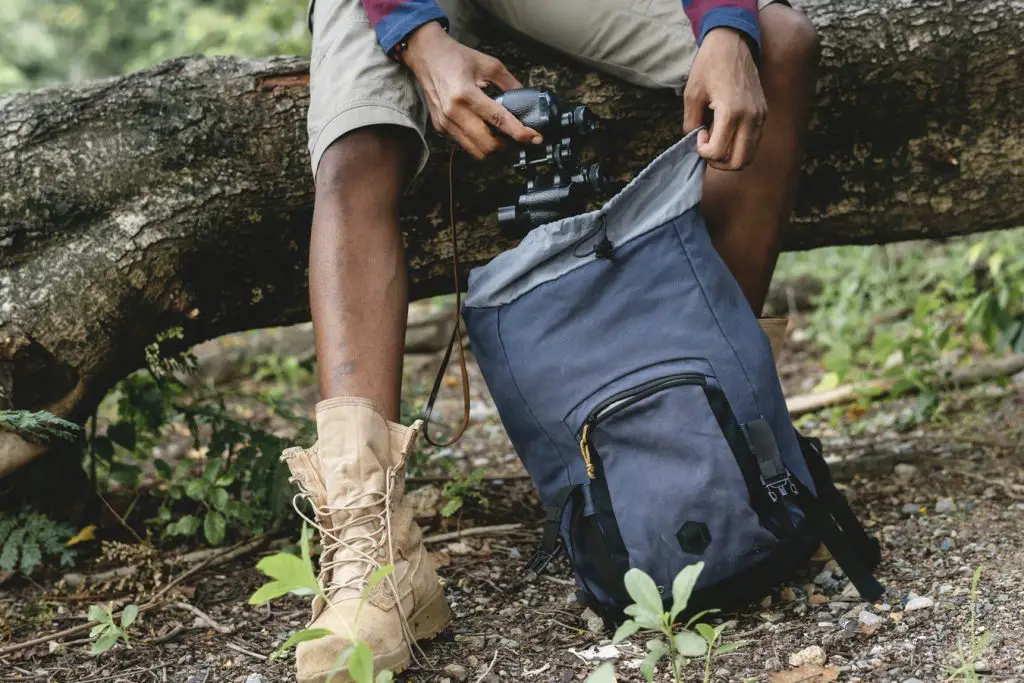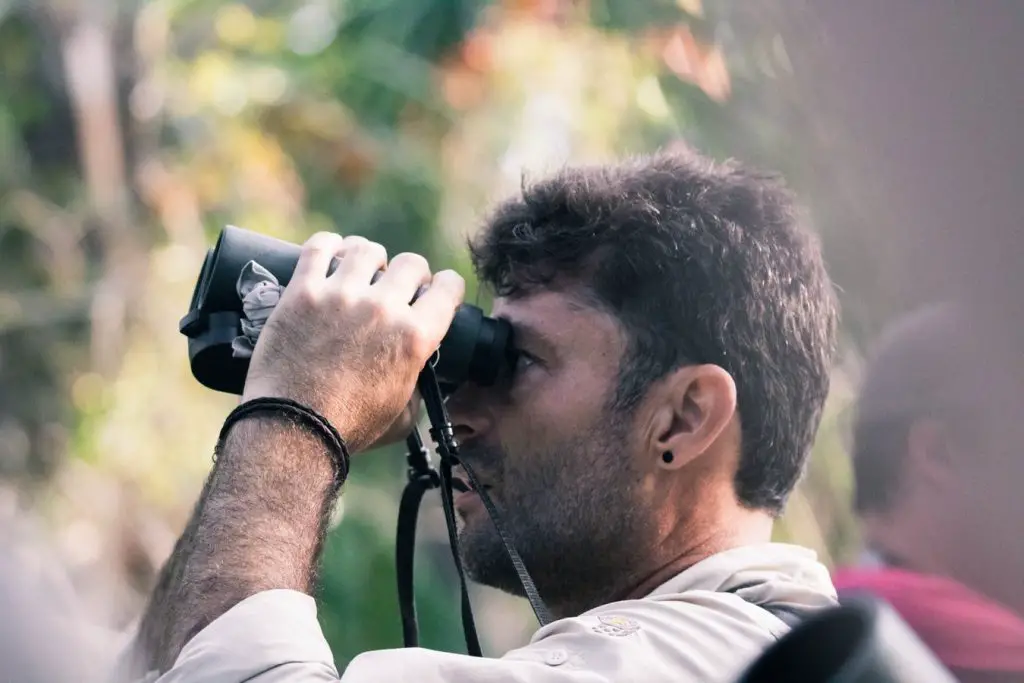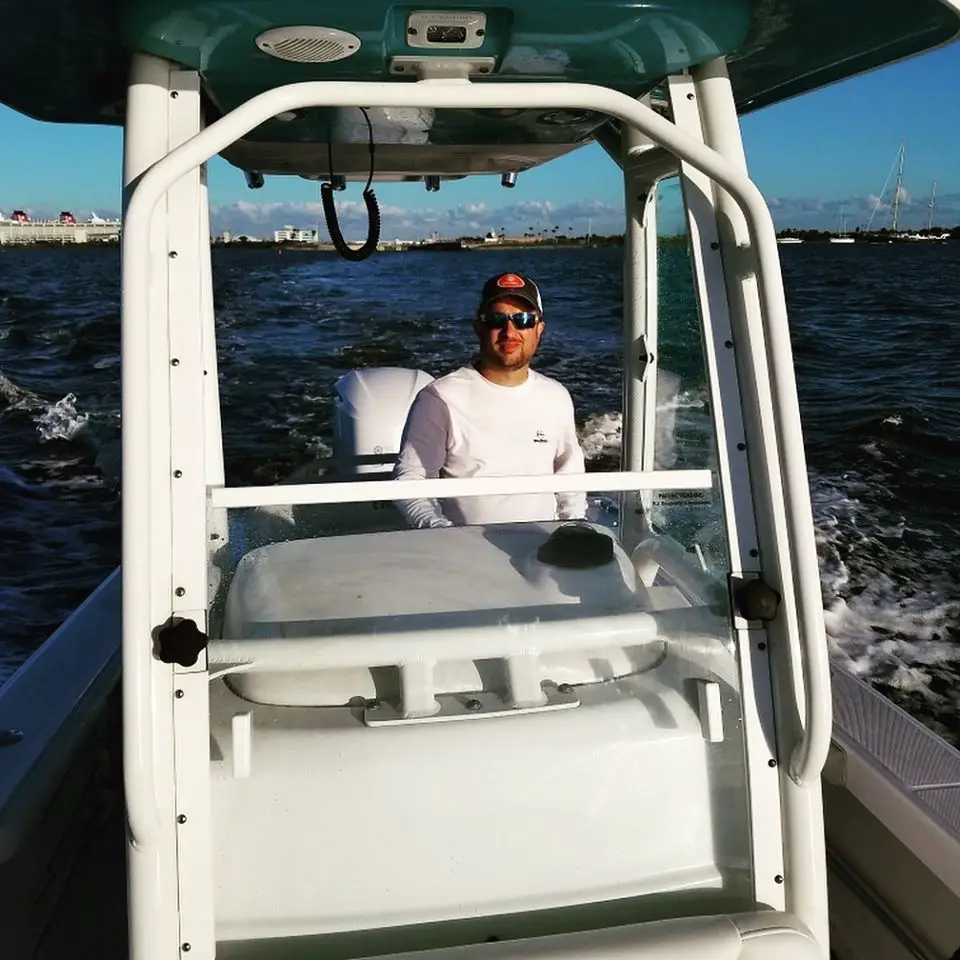This page contains affiliate links. This means that we may get a small commission for recommending products, if you choose to click on something and buy it. This does not cost you anything, but we wanted to be honest and let you know!
(Last Updated On: )Binoculars date back centuries but some are designed for certain applications, such as bird watching, hunting, astronomy and much more. Marine binoculars are primarily a 7 x 50 mm specification, which provide the perfect magnification, exit pupil size and objective size within the marine environment.
The best marine binoculars are the Steiner Navigator Pro with an impressive autofocus system and rugged polycarbonate construction that is designed for the marine environment. If you are looking for a more affordable alternative, the Bushnell H20 binoculars offer reliable and fog-free performance.
For those new to the world of binoculars, the specification of the marine binocular is 7 x magnification with 50 mm objective lenses. On top of this, they must be suitable for the environment, which means they have to be waterproof and generally durable.
Table of Contents
Best Marine Binoculars
| Marine Binoculars | Preview | Compass |
| Bushnell H2O | 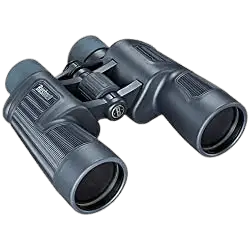 | No |
| Steiner Navigator Pro | 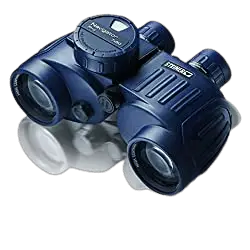 | Yes |
| Steiner 575 | 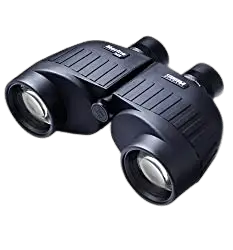 | No |
| Nikon 16026 OceanPro | 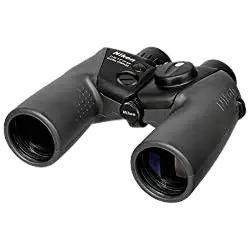 | Yes |
| BARSKA Deep Sea | 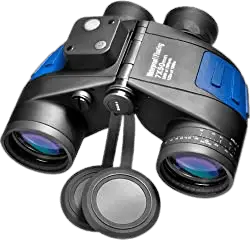 | Yes |
Binoculars that are used in the marine environment can be used for ocean viewing, whale watching, fish watching, viewing incoming vessels and much more.
Therefore, marine binocular manufacturers continually test within these situations and with the 7 x 50 mm setup for maximum performance.
Desirable features of marine binoculars include anti-fog properties, ability to float on water when submerged, built in compasses, corrosion resistant and more.
Factors such as the field of view, armoring, lens, magnification and more determine the performance of the binoculars. Below is a list of the best marine binoculars that provide crystal clear vision and are durable within the marine environment.
Bushnell H2O Waterproof Binocular
Bushnell is a popular brand when it comes to binoculars and rangefinders for golf and hunting. These H20 marine binoculars that they have to offer provide a 100% waterproof construction that is O-ring sealed and nitrogen purged for a reliable and fog-free performance, which is crucial in the marine environment.
Bushnell offers the H20 model in a range of sizes that include 7 x 50 mm and 8 – 12 x 42 mm. In terms of the vision, it uses a BaK-4 prism and multi-coated optics for improved light transmission and crisp clear images.
Other features of the Bushnell H20 include a non-slip rubber armor, soft texture grip, large center vision knob, twist-up eyecups, and a limited lifetime warranty.
Overall, they are the best marine binoculars for the money and have been designed to last. One thing that does let the Bushnell H20 down is the weight, which is on the heavy side and means that these binoculars will not float.
Pro Marine Binoculars
For those looking for an extra special marine binocular with every feature you can think of, then the Steiner Navigator Pro is one to take a look at.
It offers the marine standard of 7x magnification with stable image tracking that will remain steady even when in rough waters. Some of the features of the Navigator Pro include:
- Sports autofocus system
- Rugged construction to withstand 11G of impact
- N2 injection seals at 14 PSI of pressure
- Water-resistant coverage up to 16 feet
- Analog compass
- Lifetime warranty
Due to the lightness, you can purchase the additional floating strap and the Navigator Pro will float on water when submerged too.
Overall, these are the best marine binoculars for those looking for the ultimate example but they do come at a premium, which will put many people off purchasing them.
However, when you dig deep into the build quality, stability, waterproof and anti-fog capabilities, you will see that they are a worthwhile investment.
Steiner Marine 7×50 Binoculars
Steiner offers a range of marine binoculars and if you want to stick with the brand but cannot stretch to the cost of the Navigator Pro, then these are the best alternative.
They use the same Steiner’s Sport Auto Focus system and BAK-4 prism technology for unmatched optics within the marine environment. In terms of the field of view, you can expect 356 feet at 1,000 yards.
As with the Navigator Pro, it has the same durable construction, which includes a Makrolon housing and polycarbonate chassis that can withstand 11 G’s of impact.
Many of you are probably thinking about what the main difference is between the two Steiner marine binoculars. The main difference is the HD stabilized compass but if this is not a desirable feature, then you may as well save money and purchase these Steiner marine binoculars instead.
Nikon 16026 OceanPro
Nikon is another brand that needs no introduction and their OceanPro marine binoculars are built to a high standard with a rubber armored, shockproof polycarbonate body. They are also lightweight included with the package is a floating strap, which ensures that these binoculars float on water.
They are only available with the marine standard specification (7 x 50 mm) and they are nitrogen-filled and O-ring sealed in order to be 100% waterproof and fog proof.
The Nikon OceanPro has been designed for wet and rough environments such as ski boats, fishing boats, and personal watercraft. To factor in the changing weather conditions, these marine binoculars use multiple layers of anti-reflective coatings to deliver superior brightness, resolution and high contrast for bad weather.
Overall, these OceanPro marine binoculars follow the reputable Nikon tradition of high-quality devices that are built to last. Considering the big brand, they are also priced fairly and offer great value for money.
BARSKA Deep Sea Floating Binoculars
The BARSKA marine binoculars are a budget marine binoculars that offer “a lot of bang for your buck“. It features an internal rangefinder, compass, BAK-4 prism technology, floating capability and much more.
Just like the more expensive alternatives, these marine binoculars are O-ring sealed and nitrogen purged and sealed to prevent fog building up and moisture build-up.
In terms of the specification, it uses the standard marine 7 x 50 mm with a 395 feet field of view at 1,000 yards. BASKRA also provides a limited lifetime warranty with these marine binoculars and a carrying case and neck strap are included.
Overall, these are cheap marine binoculars that provide a range of features and high performing functionality. You will not be disappointed with these and they offer excellent value for money compared with the alternatives.
Marine Binoculars Buying Guide
Selecting the right binoculars for you to use while on a boat can be difficult since some come with features better than others.
Furthermore, deciding the right binoculars is crucial since looking over water is a challenge; therefore, the binoculars must be designed for this specific purpose.
It is for this reason that marine binoculars exist since they have additional features that make them an excellent choice for you when on a boat. This article aims at enlightening you on what to look out for when searching for the high-quality binocular that fits your budget.
How to Measure Marine Binoculars
The description of binoculars is either eight by twenty-five or seven by fifty with the latter being the classic binocular size for marine use.
The seven pinpoints the magnification power whereas the fifty is the diameter of the objective lens measured in millimeters.
Three main characteristics of these 7×50 binoculars that make them an excellent choice for marine use are that they use sizeable objective size, conservative enlargement and generous size of the pupil.
Magnification power specifies how close the object appears while viewing through the lens, and this when using a 7×50 binoculars seven times larger.
Moreover, an increase in magnification level results in a reduction in the brightness level of the image, thus to maintain the brightness level necessitates the use of a larger objective lens. It is because the wider the glass, the more the light that can gather.
However, it is important to note that the more you increase magnification, the more the image shakes as a result of both unsteady hands and the vessel’s movement.
Hence, to ensure your viewing is moderately stable is by limiting the marine binocular’s power to about 7x. Below are some features that you should look out for before buying marine binoculars.
Size of the Objective Lens
It is usually the size of the lens at the binocular’s tip with a larger objective lens able to gather more light thus the resulting image will be brighter, something to have in mind if you are planning to use the binoculars early in the morning or at dusk.
However, the bigger the lens, the bulkier the binoculars, with the size of objective lenses ranging in between 30mm to 50mm.
Magnification
Unlike inland, when out on sea the objective is to see objects that are in far distances, therefore the higher the magnification, the better your view.
Nevertheless, the main issue with this is logic because higher magnification levels cause image stabilization problems.
Thus, for boat use, binoculars with a magnification power of 7x are practical since they provide you with adequate power without affecting the stability of the image.
However, binoculars coming with an image stabilization feature allows magnification of up to 18x since they automatically compensate for the boat movement.
Water-resistant and Fog-proof
Marine binoculars must be waterproof. However, despite most of the binoculars offering protection against water, they do not do the same for fog.
It is thus vital to ensure the binoculars you purchase contains an O-ring seal and has been charged with dry nitrogen gas that prevents fogging that occurs as a result of rapid temperature changes.
Having that in place ensures your binoculars are secure from both water and fog which will be advantageous in protecting it from corrosion mainly if you use your binoculars out in the ocean.
Prisms
The function of prisms in binoculars is inverting and magnifying an upside-down image, and they are two types, Porro prisms or roof prisms.
The Porro prisms are binoculars that have a dog-like shape whereas the roof prisms are binoculars that come with a straight tube shape which is even easier to grip.
Whereas there are disagreements as to which of the two is the best, generally the Porro prisms result in a higher optical performance since they convey more light leading to brighter images and better depth perception since the objective lenses are farther apart.
Nonetheless, some roof prisms do have a phase shift coating do deliver outstanding performance.
Glass types in prisms are of two kinds, BAK-4 and BK-7. The BK-7 uses borosilicate glass while the BAK-4 uses a thin, denser barium crown glass that does a better job at eliminating internal light scatters and produces sharper images in comparison to BK-7. The better quality offered is evidenced by a price difference.
Roof prisms are lightweight and, but their manufacture is more complicated and has more precise tolerance thus more expensive to manufacture compared to Porro prisms.
Field of View
The field of view is the horizontal width you can view while looking through the binoculars. Typically, the wider the field of view, the easier it is to locate and detect subjects while looking through your binoculars and this while on water enables you to recognize different items in your view.
Conversely, the narrower your field of view the harder it is to identify an object in your field of view. When considering binoculars, factor in the fact that the field of view might affect eye relief.
Individual Focus or Center Focus
Binoculars usually have independent eyepiece focus to compensate for the differences between eyes and different distances.
While which type of focus is better is a matter of preference, most marine users prefer the individual focus variety which focuses each eyepiece independently.
It negates the need to focus every time you are using the binoculars. Center focus, on the other hand, is more old-fashioned since the focus knob switches the focus on both eyepieces.
For binoculars used with many people, the center focus is more beneficial and easy to use while the individual focus is ideal only if you are the only one using the binoculars.
Lens Coating
The coating of the lens is done with the use of chemicals which subsequently reduces the internal reflection from 5% to 1% or less.
The coating is done because whenever light enters or leaves a piece of glass, approximately 5% is reflected leading to a reduction in contrast image, sharpness and brightness level of the binoculars.
There is a variation in coatings and looking outside the surface of the lens you will be able to tell that, quality coatings having a subtle green, blue or violet appearance.
The more the number of layers and complex chemical compositions on the surface of the lens, the higher the light transmission of the binoculars.
Armoring
While on the boat, objects accidentally get knocked around and thus most marine binoculars to prevent easy damage have a suit of armor made of rubber, or in some cases the tubes being made out of rubber-coated polycarbonate.
Furthermore, this rubber treatment provides you with a higher grip on the binoculars.
Floating Strap
Whereas some marine binoculars can float, most of them do not. It is thus critical to purchase floating straps which you will attach to your binoculars just in case your marine binoculars fall into the water.
The floating straps stay afloat for long enough giving you adequate time to go and fetch them out of the water.
Weight and Size of Binoculars
The weight and size of your marine binoculars really should not matter because they are typically kept on the boat, and you only use them when on water. However, if you are planning to utilize them for other issues apart from boating adventures, you have to consider this.
Conclusion
Using a pair of binoculars that are suited to the rough marine environment and have qualities that make seeing oncoming vessels, fish, whales and other objects clearly are highly desirable.
The majority of marine binoculars use a 7 x 50 mm specification and features such as a stabilizer, focus system, and compass to increase the usability.
All of our recommendations suit a range of budgets and will not disappoint.







